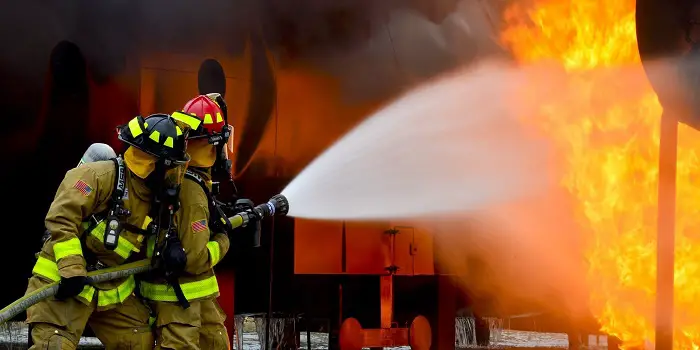
One of the biggest enemies of wood is fire. However, you can make your wood structure fireproof if you use the right substances and materials which protect against heat and flames.
The process of making wood heat- and fire-resistant can be inexpensive and effective when you use the right fire-retardant chemicals. The most effective is a combination of zinc chloride, ferric chloride, and water that can be sprayed on wood to slow down the spread of a fire.
- Start by filling 0.5 gallons (2 quarts) of water in a bucket
- Add 1/2 cup zinc chloride and 1/4 cup ferric chloride into it
- Also, add 3 tbsp. of boric acid and 3 tbsp. of ammonium phosphate
- Mix all these chemicals thoroughly in water, then spray or paint over the wood surface you want to fireproof
- Make sure you add at least 2-3 coats of this mixture to the wood to get better protection from fire.
While this method doesn’t make your wood completely fireproof, it can resist the fire very efficiently so that you get enough time to get it off before it spreads and gets uncontrollable.
What Type of Wood is Fire Resistant?
Keep in mind that fire-resistant does not mean fireproof. There are certain types of wood that are more resistant to fire, such as hardwoods.
Such hardwoods include mahogany, maple, oak, teak, ipe, and walnut. These are far slower to burn compared to softwoods. However, over time the hardwood species will char and heat up considerably.
The key component that makes wood difficult to burn is the porosity of the grain. The less porous the grain, the harder it is for oxygen to get in and assist with the burning.
The following types of wood are the most resilient to fire and will tend to smolder instead.
- Apricot, Burch, and Elm
- Oak, Rhododendron, and Ericales
These types of wood are very hard to catch fire, especially oak, if it has been waterlogged for years.
As you might suspect, fire retardant wood has been used for many centuries for various applications. So, let’s check them out in our next section below.

What is Fire Retardant Wood Used for?
Given how helpful wood is in so many projects, having it be fire retardant provides additional protection in the worst cases.
Exteriors:
This normally means shingling and construction of the roof. Given how vulnerable these areas are during a fire, using this form of wood protects the structure from fireworks, lightning strikes, and wildfire.
Local building code requirements may include the use of fire-retardant wood for the structure and framing of your home. It is cost-effective and relatively easy to use in such circumstances.
In addition to the standard exteriors, this type of wood is also quite appropriate for the following structures.
- Feed Storage Barns
- Outbuildings
- Sheds
- Stables
- Workshops
Wood that is naturally fire retardant is generally better to use in such circumstances compared to coatings or preserved wood.
Interiors:
Primarily, fire retardant wood is used to create the structure of homes and other types of buildings where steel is not necessary or desired.
The use of fire-retardant wood slows the spread of a fire and helps to contain it once the fire department arrives.
It is a solid choice for stand-alone housing, but it also works for row houses and townhouses.
When added to high-traffic areas inside a residency, it helps keep the structure together in case of fire. This helps buy enough time for those inside to escape or for fire department personnel to reach them.
But there are more applications for the interior of homes, such as the following.
- Exhibition Stands
- Internal Partitions
- Storage Areas
- TV & Theater Decorations
Residential Buildings:
Apartments and condominiums can benefit from this type of wood for balconies, decks, rails, siding, soffits, staircases, trim, and more. This will help to make the structure easier and less expensive to insure.
They also work for buildings that are next to bushes, trees, and other natural features that might contribute to a fire.
Plus, exterior buildings that contain flammable materials such as grain, hay, or sawdust should be enclosed in fire-retardant wood.
Basically, any type of structure that is vulnerable to fire is a candidate for the use of fire-retardant wood. However, there are circumstances in which other materials might be better suited.
A fire door, for example, is probably more secure using a more fire-resistant material such as metal that has a higher melting point than a typical fire can reach.

Will Charring the Wood Make it Fire Resistant?
Unbelievingly, one of the best and oldest ways to protect wood from fire is “fire” itself.
The process which we call “charring” is simply the application of heat and fire to the exterior of wood material for a very short period of time.
While this does not burn the wood completely, it changes the cellular structure as well as the thermodynamic conductivity of the lumber.
Basically, there are two constituents of wood, i.e., cellulose and lignin.
While cellulose is a fresh layer that’s present on the outer surface of the wood of a tree, lignin is a compound that gets deposited into the deep tree tissue. As the tree gets older, lignin gets even harder, tougher, and brittle.
When the tree trunk or lumber is charred, cellulose is what gets burned off. Harder lignin remains deep in the wood as the temporary heat doesn’t get enough time to burn it.
If you really want to burn the tough lignin, you will need a lot higher heat for more time. And that’s the reason when the surface of the wood for a fence or cedar siding is charred (not burnt), it makes the wood stronger and fire retardant.
The process makes the outer layer act as an insulator, due to which the charred wood is also fire resistant, which means it can resist burning and withstand heat more than the uncharred wood.
Have you ever thought about why the half-burned logs of a campfire are hard to reignite once you put off the fire?
It’s simple – because there are no cellulose compounds left in the wood that can be ignited or burnt.
How is Fire Retardant Wood Made for Buildings?
Plywood and kiln-dried untreated wood are how fire-retardant wood begins.
In most cases, a chemical is applied to the wood, which provides protection from heat and flames.
However, in virtually all cases, the wood is made using a pressure system. This pressure system is an essential part of the process because it aids in the insertion of fire-retardant chemicals.
In other words, surface treatments alone are insufficient to make the wood fire retardant.
To create the proper pressure, a retort chamber is used. The wood is loaded into the chamber, and all the air is removed so the chemicals can be applied.
The combination of chemicals and pressure fully soak the wood so that it becomes fire retardant.
Inspection:
Once the process is complete, the wood is examined by quality control specialists. Such specialists are usually not part of the company creating the product.
Samples are taken and checked for the chemicals present. Also the burn rate of the wood is checked as well. The wood must be difficult to ignite and only slowly burn to pass the quality control requirement.
Additional tests check for charring and the structural integrity of the wood itself.
For a batch of fire-retardant wood to be approved, it must get past all three steps in the process.
If it passes, then the fire-retardant wood can be sold on the market. If not, then it is either re-exposed to the chemical and pressure process to be checked again, or it is not sold as fire-retardant.

Do High Heat Paints Work Against Fire to Keep Building Safe?
Fire is a combination of heat, oxygen, and some type of fuel. All three together will create a fire that causes damage to your home.
Left unchecked, it can destroy one building and move to the next. However, if you remove just one of the three elements, the fire can be dealt with quickly.
A mass fire is one of the most dangerous because it tends to build on itself as it destroys buildings.
To fight such fires, heat-resistant paint and fire-resistant wood finishes can play an important role.
Heat-resistant paints are commonly used to slow the spread of fire so that they can be stopped before causing any more damage.
The paint not only protects against the damage from the flames themselves but the charring effect of the heat that is generated.
In addition to withstanding the heat, the fire retardant paint also prevents the underlying surface from becoming more fuel to the fire.
A wood surface, for example, would normally burn and add to the heat and flames.
But when covered by fire-resistant paint, the wood is protected from heat, and the intervening layer cannot add any fuel to the fire itself.
Additionally, the dampening effect slows down the formation of a fire and may prevent it from becoming much of a threat to the structure.
For example, a fire that starts in a trash container may die quickly because the paint protecting the walls and ceiling does not let the underlying surface contribute fuel to the fire.
You will need to shop around to find the best type of fire-resistant paint treatment for the surface that will be covered.
It should meet the standards for being fire-resistant and match the needs of the wall or ceiling to which it will be applied.
Final Thoughts
Wood is a poor conductor of heat, but it can catch fire easily. So, it pays to protect your home in every way possible. This includes protection against fire, one of the most common ways a home is damaged.
Fortunately, making your wood structures fireproof is now possible, which includes using fire-retardant wood, high-heat fire-resistant paints, and many more.
Choose the method that works for you, and hopefully, you can keep your property safe from fire hazards.

Hi, I am Mark Garner a professional carpenter, woodworker, and DIY painter. I live in the small city of Peoria, Arizona as a semi-retired woodworker. I have started this blog with a simple motive to help you with my wood experience in this sector. If you like to know more about what I love doing and how it all got started, you can check more about me here.




